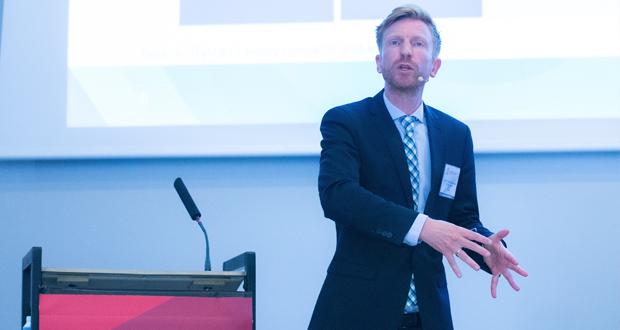Rystad: Industry will face more structural shifts in its balancing act to provide secure, affordable and sustainable energy

By Stephen Whitfield, Associate Editor
The global energy industry is in the midst of a “trilemma,” a balancing act of providing to the world energy that is at once secure, affordable and sustainable. All three legs of this triangle need to be balanced, and yet they haven’t been for the past seven years, according to Lars Eirik Nicolaisen, Senior Partner and Deputy CEO of Rystad Energy. “Since 2015, the focus of the industry, of public opinion, of capital markets and of politicians have been rather one sided. There’s been a massive focus on sustainability.”
Speaking at the 2022 IADC World Drilling Conference in Paris on 21 June, he noted that 2015 was an inflection point for a couple of reasons. First, that was the year the Paris Climate Accords was launched, putting great momentum behind sustainability efforts worldwide. Second, and perhaps more importantly, the massive influx of hydrocarbon supplies from North American shales led to big drops in energy prices. “Affordability was sort of solved for, and we started talking about energy abundance instead of energy scarcity,” Mr Nicolaisen said. “We allowed ourselves to stop focusing on the security and reliability of supply – we had so much. That, I will say, is a pillar of why we have allowed ourselves to be so one-sided in our focus since 2015.”
An example of such one-sided sentiment is the “Net Zero by 2050” report, issued by the International Energy Agency (IEA) in May 2021. In presenting the so-called “roadmap for the global energy sector,” the IEA Chief called for politicians to stop sanctioning oil and gas projects – even while oil demand was surging because countries were starting to loosen their COVID-related restrictions, Mr Nicolaisen said. But the IEA statement was “dangerous,” he added, because if you discourage investments in the supply of hydrocarbons while demand is increasing, “you end up in a crunch.”
That energy crunch manifested by the second half of 2021, and was then followed in early 2022 by Russia’s invasion of Ukraine. The third leg of the trilemma – energy that is secure – began to shake, adding new considerations to the debate around the energy transition, he said.
In his presentation, Mr Nicolaisen discussed two distinct phases that he believes will unfold over the short- to medium term. “Phase One is the place we’re in right now,” he said. “We are in a scramble. Why? Because it’s a rush to bring hydrocarbons online – hydrocarbons that are outside of Russia.” While this could reinvigorate the oilfield service industry, it will face new challenges brought on by “a massive inflationary environment, not just in oil and gas but in all commodity markets.”
Phase Two, he continued, will involve more structural changes. The EU, for example, remains heavily reliant on gas imports from Russia. While there’s a call on Norway to contribute to Europe’s natural gas supply and make up for Russian gas, it could be the US that will be the country to see incremental benefits. “The US has become a significant gas exporter through the route of LNG, and right now the facilities are skyrocketing from an activity standpoint, in some ways even surpassing their nameplate capacity,” Mr Nicolaisen said.
On the oil side, the EU is apparently trying to eliminate its imports of 3 million to 3.5 million bbl/day from Russia – and to achieve this in a six- to eight-month period, according to Mr Nicolaisen. “This is an unprecedented change and redirection of oil flows in the global oil market,” he said. Moreover, because there’s not enough infrastructure to redistribute all this crude to Asia through pipelines, it will lead to a “2-2.5% supply destruction over a six-month period. This is an extremely challenging situation,” he cautioned.
So who can step up and fill this void? OPEC comes to mind, he said. Looking at recent trends in Middle East tenders and contracts for jackups, it’s evident they are scrambling for incremental supply. Saudi Aramco, for example, awarded contracts for 26 jackups from March 2022 through the end of May – a key indicator of a massive ramp-up in activity. Rystad said it expects the jackup market to enjoy a short-term uptick well into next year, before cooling off again in 2024 and 2025.
Phase Two will also likely include a normalization of the oil price, likely to happen in 2023 or maybe 2024. While in the near term, oil prices will stay high due to the combination of supply disruption and increasing demand, high prices could come hand-in-hand with a recession. “It can take us swiftly down to $40 or even $30 per barrel,” he said. This would be especially bad for the offshore market, whose longer timelines require more stability. This means that, although Rystad is forecasting oil prices could surpass $185/bbl in its high-case scenario, he hopes it doesn’t. Rystad’s mid-case scenario – in which Brent would stay around its current levels of around $100-110/bbl for the rest of the year before declining into the $70s by the middle of next year – is more preferable, he said.
For floating rigs, Mr Nicolaisen said the offshore industry is “truly building momentum” and expects there to be an exciting cycle over the next couple of years, with already-discovered deepwater basins in Guyana and Brazil likely the main drivers of activity. “Our industry has consolidated,” he said. “I think pricing power has switched towards the suppliers here.”




